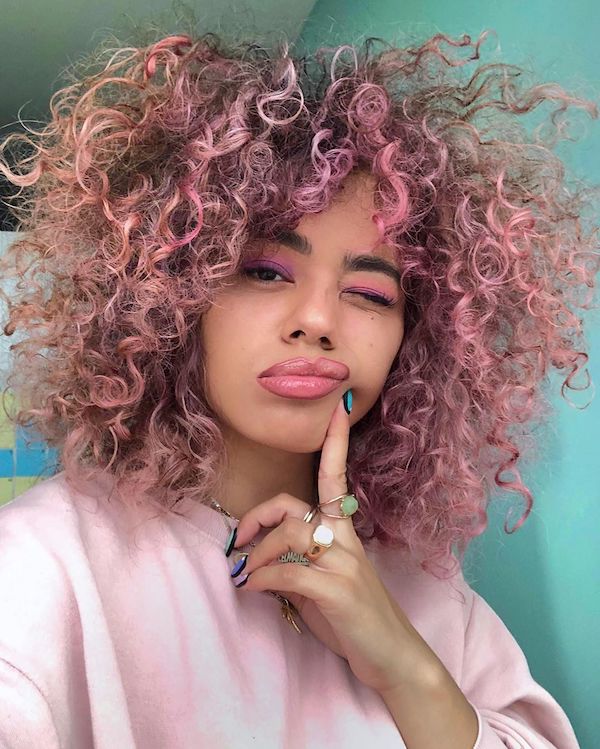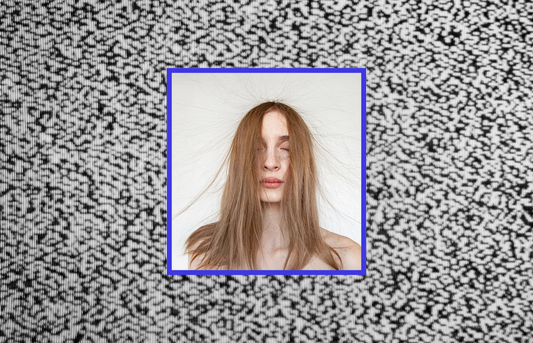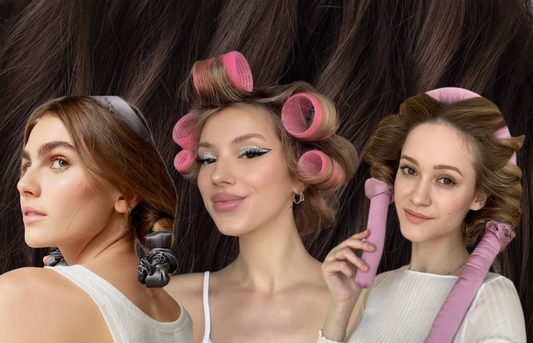How To Use The Curly Girl Method For All Hair Types
Curls get the girls... and all the hair problems! Let us solve your curly girl woes.
In this article
The curly girl method is a hair care routine that is a godsend for girls with ringlets, waves and afro curls alike.
But where to start?
I get it; hair care is complicated! But, I am here to teach how to use the curly girl method for ALL hair types.
Now, when I say 'for all hair types" you may be thinking, but it's curly girl method.. isn't it just for curly hair? And yes, you are correct.
But, what type of curly hair do you have?
Did you know there is so much more to hair types than just the texture and thickness? Especially when it comes to curly hair.
But more on that later. For now, let's have a little chat about what the curly girl method actually is.

Image credit: @nonnymulholland
What Is The Curly Girl Method?
The curly girl method was invented by Lorraine Massey back in 2007 and has since been adopted by curly wurly women everywhere.
This regime uses predominantly natural products to keep your curls in the best and most beautiful condition.
The CG method is underlined by a few basic principles, including:
- Ditching harmful chemicals and products from your routine and replacing them with gentle and natural alternatives
- No sulphate shampoos
- Ditching the combs (mostly) and brushing your hair with your fingers
- Adopting new and healthy hair habits
- Identifying and working with your individual curl type
As well as these golden rules, there are specific steps to follow for the curly girl method too.
Curly Girl Method Steps:
- Shampoo once or twice a week with sulphate-free products.
- Condition regularly and according to your curl type... More on that later.
- Ditch the heat tools when styling. Heat cause dry and damaged hair so cut back as much as you can.
- Apply a treatment suitable for your curls once or twice per week.
- Only use curly girl approved products - these are natural and suited to your needs.
So want to know how to make the curly girl method work for your hair type?
We know you do.
Let's work out what your curl type is and what products you should be adding to your curly girl routine.

The Medium Halo in Col. Light + Medium Brown 4/6
What Is My Curl Type?
You might want to take notes.
Hair type 1 is straight, so let's forget that for now.
But, there are 3 different curl types, each with A, B and C subtypes. The curly girl method can be adapted for each of these hair types.
The shape which your follicles grow out of your head determines your curl type.
For example, if the follicles are more oval-shaped or flatter, the curlier your hair will be.
The shape of the strands also indicated the types of curls you have.
Strands can kink, curve, spiral or in my case, impersonate a tangled slinky. They can even form multiple curl shapes at once.
Which means you can have more than one curl type.
In fact, this is usually the case.
So if you do have multiple curl types, you may want to consider differentiating your CG method accordingly.
So want to figure out what kind of curly hair you have?
Allow me.
The three different curl types are:
- Type 2: Waves
- Type 3: Curls
- Type 4: Coils
Now let's talk more about curl types and subcategories!
Read: 5 Different Ways To Curl Your Hair

The Thick Halo in Col. Medium Brown #4
Curl Type 2: Waves
Wavy hair is curl type 2.
This hair type is known for its bendable natural and desiccative pattern.
Wavy hair can be fine or coarse and usually lays close to the head.
As with all curl types, wavy hair has subcategorises A-C.
Type 2A
Typified by its is tousled and super lose texture, this wave is usually found in fine hair.
Lacking volume in the roots these waves can look limp and lifeless on occasion.
Some days type 2A waves could even be mistaken for messy straight hair, especially if you're not styling them right.
This is why it's important to nail your curly girl method to take your barely-there beach waves to textured, tousled tresses.
So what kind of curly girl method should you use for type 2A waves?
These waves usually have a medium to low porosity (ability to retain moisture), so keeping them hydrated is key.
Your CG routine should include a hydrating shampoo and conditioner and hair oil to help keep frizz under-control too.
It would help if you also used water-based gels and mousses when styling to keep your locks looking and feeling light.
Read: How To Get Natural Waves at Home

The Medium Halo in Col. Light Brown #6
Type 2B:
Surfer strands type 2B waves are known for their define S-bend starting from the mid lengths.
They are thicker than their tousled twin Type 2A and lie flatter at the crown of your head.
Too much of the wrong products can make these boho barrels look stiff, so you want to keep styling on the light side.
So let's talk the best curly girl method for type 2B waves.
As these waves a beachy and lose in nature, you will want to create some shape when styling.
Stick to a curl whip mousse to help achieve a defined yet soft and subtle S-bend.
Anything too heavy with cause the hair to look and feel crunchy.. not cute.
As for hair care, 2Bs can be prone to frizz and dehydration so you should add a hydrating mask to your hair routine twice a week.
You should also opt for water-based products in cream formulas when styling.

the thick Halo in Platinum Blonde #60
Type 2C:
Honey’s with the curl type 2C are probably more prone to frizz than their subtler s bend sisters.
This curl type features smaller, tighter S-bends that begin at the roots.
Annnnd might require a little more TLC when styling and when developing your CG method.
Type 2C is smooth yet, in typical type 2 fashion still prone to frizz and very prone to heat damage.
This hair care method is very similar to the above, you should be applying a hydrating hair mask twice per week opting for water-based, cream styling products.
A leave-in conditioner is also recommended twice a week to help seal in hydration.

The THICK halo in col. Beige Blonde #613.
Curl Type 3: Curls
From bouncy to loose, tight and spring curls come in many shapes and sizes.
And think all type 3 hairs have in common is, they can be prone to frizz.
So this will be a major issue to address over your curly girl journey.
Type 3A:
Wide, loose locks Type 3A curls are spirals that don't have a lot of shrinkage.
The circumference of the curl should be able to fit around a permanent market.
With these types of curls, you are cautioned against shampooing too frequently as it can dry your locks out.
Try shampooing every 5 days if you can and opt for hydrating hair masks and leave-in conditioners instead.
When heat styling always is diligent with heat protection spray and aftercare.
Add a curl refresher spray to your regime to keep your strands shiny.

Image credit: @abbiechatfield
Type 3B:
These are tighter curls with spring back of about 2 - 3 inches.
They're probably loser around your face but tighten to about the width of a pencil toward the back fo your head.
As with all curls, dryness is the devil, so you should keep washing down to once a week.
With this curl type, you should incorporate heat into your curly girl method.
But I don't mean breaking out the blowdryer.
I mean using a heated shower cap to active your hair care ingredients.
Once or twice a week, apply a hydrating hair mask or deep conditioner.
Then warm a shower cap in the microwave or with your blow dryer and wear it as normal.
This helps activate the ingredients and helps them penetrate your strands.
For styling opt for lightweight creams, oils and butter.
These will help you form a defined shape for your curls while giving them a boost of moisture too.

Image Credit: @celmatique
Type 3C:
These curls come in a few different textures.
You may have a head full of zigzags and corkscrews that vary in tightness, but fret not, your natural texture should be similar for each strand.
Type 3C curls are usually coarse and need to be treated gently.
Your curly girl method should include leaving in conditioner and a wide-tooth comb to detangle.
You should also invest in hair oil to help your curls retain moister to keep them on the softer side.
Lose the lightweight styling creams and go for something a little denser to lock in lustre and help your curls look lush.
Ingredients such as avocado and olive oil will work wonders for your head.

Image credit: @milakarumbi
Curl Type 4: Coils
Kinky or afro texture hair is type 4, coils.
Strands grow in tight, small curls or zigzags directly from the scalp.
This curl type is usually dry in texture particularly prone to shrinkage.
Type 4A:
These coils have dense and springy spirals with a very, very small circumference.
In fact, these curls are only about the width of a toothpick.
Prone to dryness, your curly girl routine should focus on hydration.
You should not wash your hair frequently and use oils, leave-in conditioners and hair masks a few times per week.
This will keep your coils looking and feeling fresh and lush.
When styling goes for aloe-based curl enhancing gels.

Image credit: @ashhalvarez
Type 4B:
More of a zigzag than a curl, type 4B coils form a Z-bend instead of the. Typical S-bend.
They are porous, fragile and prone to breakage.
So as you might have guessed, this curly girl method is all about hydration, hydration, hydration.
Again, something most curls have in common is dryness.
You want to boost moister, shone and strengthen and minimise frizz, breakage and brittle strands.
So, for type 4B coils focus on thick creams that deeply condition and nourishing.
Always start with a heavy product for styling prep too.
Anything to lightweight won't penetrate your strands.

Image credit: @tayercmone
Type 4C:
These coils are so tight it can be hard to see the zigzag pattern, but it is definitely there.
These coils wrap themselves around each other, meaning there is less drop to the curls.
Similar to their slight loser pal, 4B, 4C coils require a lot of TCL when it comes to hydration and conditioning.
Your curl girl method should include heavy-duty hydrating pomades and gels and products made with butter (especially shampoos).
4C coils are the most fragile of all the curl types, so keep this in mind when heat styling.
If you can avoid it all costs, but if not always use a top-quality heat protector.
This will stop your strands snapping and shirking due to damage.

Image credit: @joiwade_
You might also like:

Just high quality, beautifully designed halo hair extensions for natural, down to earth bombshells.
Shop now








